An Evaluation of the Effect of Fuel Injection on the Performance and Emission Characteristics of a Diesel Engine Fueled with Plastic-Oil–Hydrogen–Diesel Blends
Abstract
:1. Introduction
2. Materials and Methods
2.1. Experimental Setup
2.2. Uncertainty of Experiment
3. Results and Discussion
3.1. Brake Thermal Efficiency
3.2. Brake-Specific Fuel Consumption
3.3. Exhaust Gas Temperature
3.4. Cylinder Pressure
3.5. Maximum Pressure Rise Rate
3.6. Ignition Delay
3.7. Smoke Emission
3.8. Oxides of Nitrogen Emission
3.9. CO Emission
3.10. HC Emission
4. Conclusions
- The maximum brake thermal efficiency (BTE) observed for a DP20H15 mixture containing 15% hydrogen with 85% DP20 is 37.0%, while the lowest BTE recorded for D100 fuel is 30.75%. This indicates that the BTE has seen a 16.8% increase. The improved performance of the engine may be attributed to the reduced stiffness and density of the hydrogen sample, which facilitated the efficient fragmentation of hydrogen into smaller particles. Additionally, DP20H5 displayed a reduction in fuel consumption of 10.9% at 23.5 b° TDC at full load conditions.
- According to the available information, it has been reported that the lowest specific fuel consumption (SFC) for a mix of DP20 with 15% hydrogen is estimated to be 142.0 g/kWh. In contrast, the maximum SFC recorded for D100 fuel is reported to be 275.5 g/kWh.
- The increase in pressure inside the cylinder may be attributed to the change in temperature, which subsequently affected the quantity of hydrogen present in the mixture. At its maximum operational threshold, which reached around 6.5% for DP20H5, 17.6% for DP20H10, and 19.7% for DP20H15, the fuel mix consisting of waste-plastic oil biofuel–diesel–hydrogen exhibited the greatest pressure. This study examines the impact of the addition of hydrogen on the alteration of cylinder pressure throughout the combustion process, in comparison to the use of D100 fuel.
- The introduction of hydrogen into diesel fuel shows a potential improvement in the levels of nitrogen oxide (NOx) emissions for DP20H5, DP20H10, and DP20H15 while operating at full load settings.
- A decrease in HC and CO emissions was seen in response to the rise in cylinder temperature, concomitant with an increase in the hydrogen content within the mixture of up to 23.5° b TDC injection timing. Furthermore, it was observed that the emission of HC emissions increased proportionally with the increased advanced fuel injection timing.
Author Contributions
Funding
Institutional Review Board Statement
Informed Consent Statement
Data Availability Statement
Acknowledgments
Conflicts of Interest
Nomenclature
| BTE | Brake thermal efficiency |
| EGT | Exhaust gas temperature |
| CI | Compression ignition engine |
| CMP | Cylinder maximum pressure |
| CR | Compression ratio |
| D | Diesel fuel |
| DP20 | Diesel fuel (80%) and waste-plastic biofuel (20%) |
| DP20H5 | DP20 (95%) and hydrogen (5%) |
| DP20H10 | DP20 (90%) and hydrogen (10%) |
| IC | Internal combustion |
| ID | Ignition delay |
| IT | Injection timing |
| NOx | Oxides of nitrogen |
| P | Waste-plastic oil biofuel |
| ROPR | Rise of pressure rate |
| SFC | Specific fuel consumption |
References
- Loyte, A.; Suryawanshi, J.; Bhiogade, G.; Devarajan, Y.; Thandavamoorthy, R.; Mishra, R.; Natrayan, L. Influence of injection strategies on ignition patterns of RCCI combustion engine fuelled with hydrogen enriched natural gas. Environ. Res. 2023, 234, 116537. [Google Scholar] [CrossRef] [PubMed]
- Shojae, K.; Mahdavian, M.; Baghshani, E. Investigation of piston bowl geometry, injection timing, and EGR mass fraction to improve the performance of ISM 370 diesel engine. Fuel 2022, 324, 124422. [Google Scholar] [CrossRef]
- Jafari, B.; Seddiq, M.; Mirsalim, S.M. Impacts of diesel injection timing and syngas fuel composition in a heavy-duty RCCI engine. Energy Convers. Manag. 2021, 247, 114759. [Google Scholar] [CrossRef]
- Paparao, J.; Bhopatrao, S.; Murugan, S.; Kuti, O.A. Optimization of a low heat rejection engine run on oxy-hydrogen gas with a biodiesel-diesel blend. Fuel Process Technol. 2023, 241, 107625. [Google Scholar] [CrossRef]
- Channapattana, S.V.; Campli, S.; Madhusudhan, A.; Notla, S.; Arkerimath, R.; Tripathi, M.K. Energy analysis of DI-CI engine with nickel oxide nanoparticle added azadirachta indica biofuel at different static injection timing based on exergy. Energy 2023, 267, 126622. [Google Scholar] [CrossRef]
- Arulkumar, S.; Vijayaragavan, M. The influence of hydrogen as a supplementary fuel on the characteristics of CI engines running on Calophyllum inophyllum oil diesel blend. Fuel 2023, 351, 128959. [Google Scholar] [CrossRef]
- Kakran, S.; Kaushal, R.; Bajpai, V.K. Experimental study and optimization of performance characteristics of compression ignition hydrogen engine with diesel pilot injection. Int. J. Hydrogen Energy 2023, 48, 33705–33718. [Google Scholar] [CrossRef]
- Vargün, M.; Özsezen, A.N. Evaluation of the effect of the fuel injection phase on the combustion and exhaust characteristics in a diesel engine operating with alcohol-diesel mixtures. Energy 2023, 270, 126975. [Google Scholar] [CrossRef]
- Gültekin, N.; Gülcan, H.E.; Ciniviz, M. Investigation of the effects of hydrogen energy ratio and valve lift amount on performance and emissions in a hydrogen-diesel dual-fuel compression ignition engine. Int. J. Hydrogen Energy 2023, 49, 352–366. [Google Scholar] [CrossRef]
- Paneerselvam, P.; Panithasan, M.S.; Venkatesan, G.; Malairajan, M. Optimization of common rail direct injection diesel engine performance with Melia dubia methyl ester peppermint oil blend using response surface methodology approach and investigation of hydrogen and hydroxy influence. Int. J. Hydrogen Energy 2023, 50, 796–819. [Google Scholar] [CrossRef]
- Chaurasiya, P.K.; Rajak, U.; Veza, I.; Verma, T.N.; Ağbulut, Ü. Influence of injection timing on performance, combustion and emission characteristics of a diesel engine running on hydrogen-diethyl ether, n-butanol and biodiesel blends. Int. J. Hydrogen Energy 2022, 47, 18182–18193. [Google Scholar] [CrossRef]
- Yousefi, A.; Guo, H.; Dev, S.; Liko, B.; Lafrance, S. Effects of ammonia energy fraction and diesel injection timing on combustion and emissions of an ammonia/diesel dual-fuel engine. Fuel 2022, 314, 122723. [Google Scholar] [CrossRef]
- ISBN 9782710806851; Petroleum Refining: Crude oil, petroleum products, process flowsheets. Editions Technip: Paris, France, 1995.
- Altinkurt, M.D.; Merts, M.; Tunér, M.; Turkcan, A. Effects of split diesel injection strategies on combustion, knocking, cyclic variations and emissions of a natural gas-diesel dual fuel medium speed engine. Fuel 2023, 347, 128517. [Google Scholar] [CrossRef]
- Vimalananth, V.T.; Panithasan, M.S.; Venkadesan, G. Investigating the effects of injection and induction modes of hydrogen addition in a CRDI pilot diesel-fuel engine with exhaust gas recirculation. Int. J. Hydrogen Energy 2022, 47, 22559–22573. [Google Scholar] [CrossRef]
- Faisal, F.; Rasul, M.G.; Jahirul, M.I.; Chowdhury, A.A. Waste plastics pyrolytic oil is a source of diesel fuel: A recent review on diesel engine performance, emissions, and combustion characteristics. Sci. Total Environ. 2023, 886, 163756. [Google Scholar] [CrossRef] [PubMed]
- Dasore, A.; Rajak, U.; Panchal, M.; Reddy, V.N.; Nath, T.; Chaurasiya, P.K. Prediction of Overall Characteristics of a Dual Fuel CI Engine Working on Low-Density Ethanol and Diesel Blends at Varying Compression Ratios. Arab. J. Sci. Eng. 2022, 47, 15323–15330. [Google Scholar] [CrossRef]
- Rajak, U.; Dasore, A.; Kumar, P. Effects of microalgae -ethanol-methanol-diesel blends on the spray characteristics and emissions of a diesel engine. Environ. Dev. Sustain. 2022, 25, 1–22. [Google Scholar] [CrossRef]
- Rajak, U.; Nashine, P.; Kumar, P. The effects on performance and emission characteristics of DI engine fuelled with—CeO2 nanoparticles addition in diesel / tyre pyrolysis oil blends. Environ. Dev. Sustain. 2022. [Google Scholar] [CrossRef]
- Agbulut, U.; Sarıdemir, S.; Rajak, U. TN Verma Effects of high-dosage copper oxide nanoparticles addition in diesel fuel on engine characteristics. Energy 2021, 229, 120611. [Google Scholar] [CrossRef]
- Liu, X.; Seberry, G.; Kook, S.; Chan, Q.N.; Hawkes, E.R. Direct injection of hydrogen main fuel and diesel pilot fuel in a retrofitted single-cylinder compression ignition engine. Int. J. Hydrogen Energy 2022, 47, 35864–35876. [Google Scholar] [CrossRef]
- Kanth, S.; Debbarma, S.; Das, B. Experimental investigations on the effect of fuel injection parameters on diesel engine fuelled with biodiesel blend in diesel with hydrogen enrichment. Int. J. Hydrogen Energy 2022, 47, 35468–35483. [Google Scholar] [CrossRef]
- Das, S.; Das, B. The characteristics of waste-cooking palm biodiesel-fueled CRDI diesel engines: Effect hydrogen enrichment and nanoparticle addition. Int. J. Hydrogen Energy 2023, 48, 14908–14922. [Google Scholar] [CrossRef]
- Adebisi, A.; Abd-rasheed, A.; Olusegun, T.; Eshorame, S.; Oguntade, T.; Aisosa, B. Effects of hydrogen enrichment on diesel engine fueled with Afzelia Africana biodiesel—TiO2 blends. Egypt. J. Pet. 2023, 32, 81–86. [Google Scholar] [CrossRef]
- Chetia, B.; Debbarma, S.; Das, B. An experimental investigation of hydrogen-enriched and nanoparticle blended waste cooking biodiesel on diesel engine. Int. J. Hydrogen Energy 2023, 49, 23–37. [Google Scholar] [CrossRef]
- Seelam, N.; Gugulothu, S.K.; Venkat, R. Exploration of engine characteristics in a CRDI diesel engine enriched with hydrogen in dual fuel mode using toroidal combustion chamber. Int. J. Hydrogen Energy 2022, 47, 13157–13167. [Google Scholar] [CrossRef]
- Tan, D.; Wu, Y.; Lv, J.; Li, J.; Ou, X.; Meng, Y. Performance optimization of a diesel engine fueled with hydrogen / biodiesel with water addition based on the response surface methodology. Energy 2023, 263, 125869. [Google Scholar] [CrossRef]
- Zhang, X.; Li, H.; Sekar, M.; Elgendi, M.; Krishnamoorthy, N.R.; Xia, C. Machine learning algorithms for a diesel engine fuelled with biodiesel blends and hydrogen using LSTM networks. Fuel 2023, 333, 126292. [Google Scholar] [CrossRef]
- Winangun, K.; Setiyawan, A.; Sudarmanta, B.; Puspitasari, I. Investigation on the properties of a biodiesel-hydrogen mixture on the combustion characteristics of a diesel engine. Case Stud. Chem. Environ. Eng. 2023, 8, 100445. [Google Scholar] [CrossRef]
- Pinto, G.M.; de Souza, T.A.Z.; da Costa, R.B.R.; Roque, L.F.A.; Frez, G.V. Coronado CJR. Combustion, performance and emission analyses of a CI engine operating with renewable diesel fuels (HVO/FARNESANE) under dual-fuel mode through hydrogen port injection. Int. J. Hydrogen Energy 2023, 48, 19713–19732. [Google Scholar] [CrossRef]
- Rajpoot, A.S.; Choudhary, T.; Chelladurai, H.M.; Rajak, U.; Sinha, A.A. Effect of oxyhydrogen as on energy, exergy and sustainability analysis of a diesel engine fueled with palm oil biodiesel. Proc. Inst. Mech. Eng. Part E J. Process Mech. Eng. 2024. [Google Scholar] [CrossRef]
- Devi, S.D.; Kumar, R.; Rajak, U. Experimental investigation of performance, emission and combustion characteristics of a CI engine fuelled by blends of waste plastic oil with diesel. Energy Sources Part A Recovery Util. Environ. Eff. 2022, 44, 7693–7708. [Google Scholar] [CrossRef]
- Lalsangi, S.; Yaliwal, V.S.; Banapurmath, N.R.; Soudagar, M.E.M.; Ağbulut, Ü.; Kalam, M.A. Analysis of CRDI diesel engine characteristics operated on dual fuel mode fueled with biodiesel-hydrogen enriched producer gas under the single and multi-injection scheme. Int. J. Hydrogen Energy 2023, 48, 28927–28944. [Google Scholar] [CrossRef]
- Barik, D.; Bora, B.J.; Sharma, P.; Medhi, B.J.; Balasubramanian, D.; Krupakaran, R.L.; Ramegowda, R.; Kavalli, K.; JS, F.J.; Vikneswaran, M.; et al. Exploration of the dual fuel combustion mode on a direct injection diesel engine powered with hydrogen as gaseous fuel in port injection and diesel-diethyl ether blend as liquid fuel. Int. J. Hydrogen Energy 2023, 52, 827–840. [Google Scholar] [CrossRef]
- Bhagat, R.N.; Sahu, K.B.; Ghadai, S.K.; Kumar, C.B. A review of performance and emissions of diesel engine operating on dual fuel mode with hydrogen as gaseous fuel. Int. J. Hydrogen. Energy 2023, 48, 27394–27407. [Google Scholar] [CrossRef]
- Ghazal, O.H. Combustion analysis of hydrogen-diesel dual fuel engine with water injection technique. Case Stud. Therm. Eng. 2019, 13, 100380. [Google Scholar] [CrossRef]
- Gürbüz, H.H.; Akçay, M.; Aldemir Akçay, I.H.; Topal, U. The effect of euro diesel-hydrogen dual fuel combustion on performance and environmental-economic indicators in a small UAV turbojet engine. Fuel 2021, 306, 121735. [Google Scholar] [CrossRef]
- Ning, L.; Duan, Q.; Kou, H.; Zeng, K. Parametric study on effects of methanol injection timing and methanol substitution percentage on combustion and emissions of methanol/diesel dual-fuel direct injection engine at full load. Fuel 2020, 279, 118424. [Google Scholar] [CrossRef]
- Zapata-Mina, J.; Restrepo, A.; Tibaquira, J.E. Assessment of the exergy, emissions, and combustion characteristics of a diesel engine operating on low-glyceride biodiesel blended with diesel fuel. Case Stud. Therm. Eng. 2023, 41, 102636. [Google Scholar] [CrossRef]
- Bakar, R.A.; Kadirgama, K.; Ramasamy, D.; Yusaf, T. ScienceDirect Experimental analysis on the performance, combustion/emission characteristics of a DI diesel engine using hydrogen in dual fuel mode. Int. J. Hydrogen Energy 2022, 52, 843–860. [Google Scholar] [CrossRef]
- Rajak, U.; Nashine, P.; Verma, T.N. Comparative assessment of the emission characteristics of first, second and third generation biodiesels as fuel in a diesel engine. J. Therm. Eng. 2020, 6, 211–225. [Google Scholar] [CrossRef]
- Mohan, R.K.; Sarojini, J.; Ağbulut, Ü.; Rajak, U.; Verma, T.N.; Reddy, K.T. Energy recovery from waste plastic oils as an alternative fuel source and comparative assessment of engine characteristics at varying fuel injection timings. Energy 2023, 275, 127374. [Google Scholar] [CrossRef]
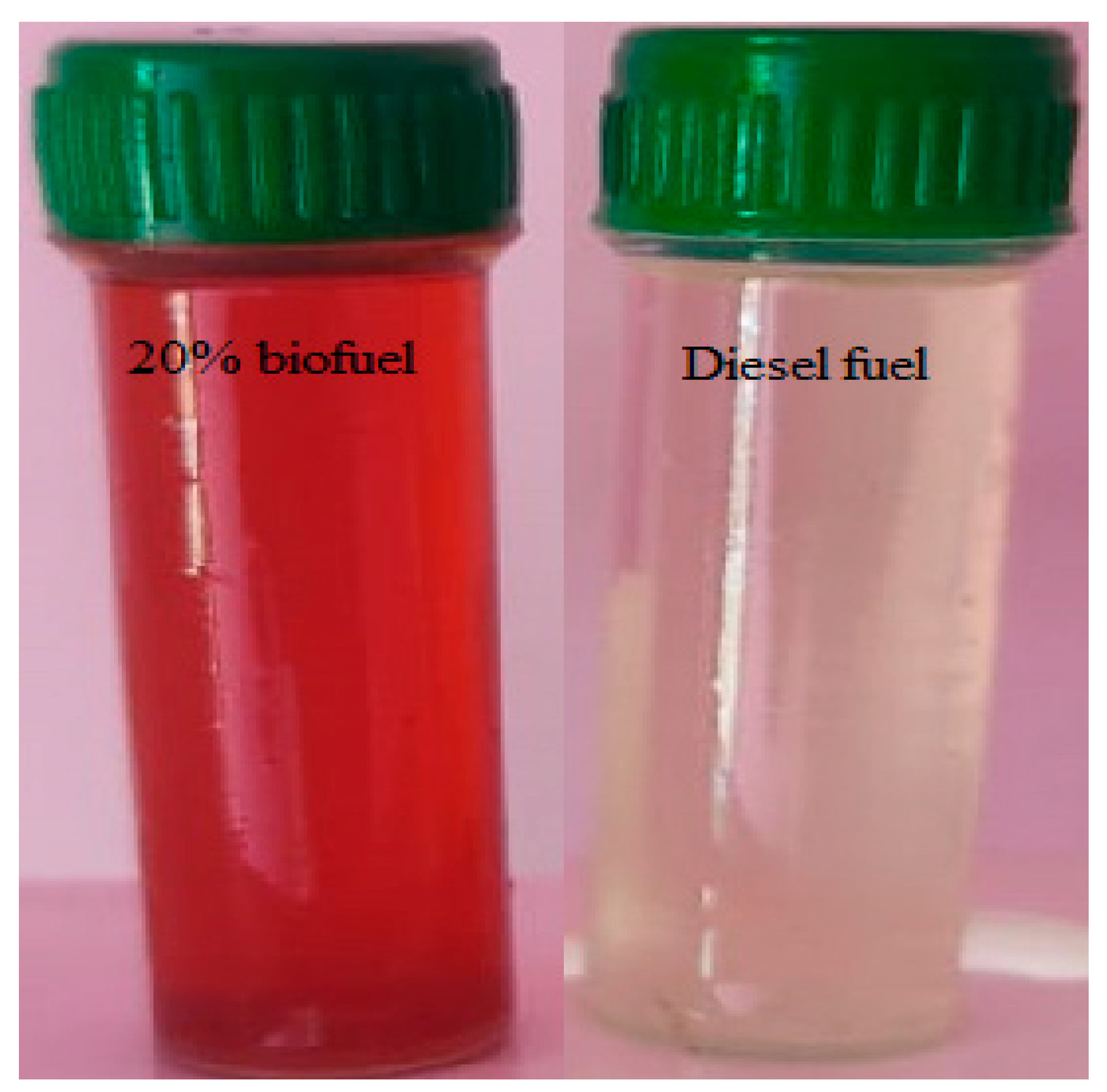
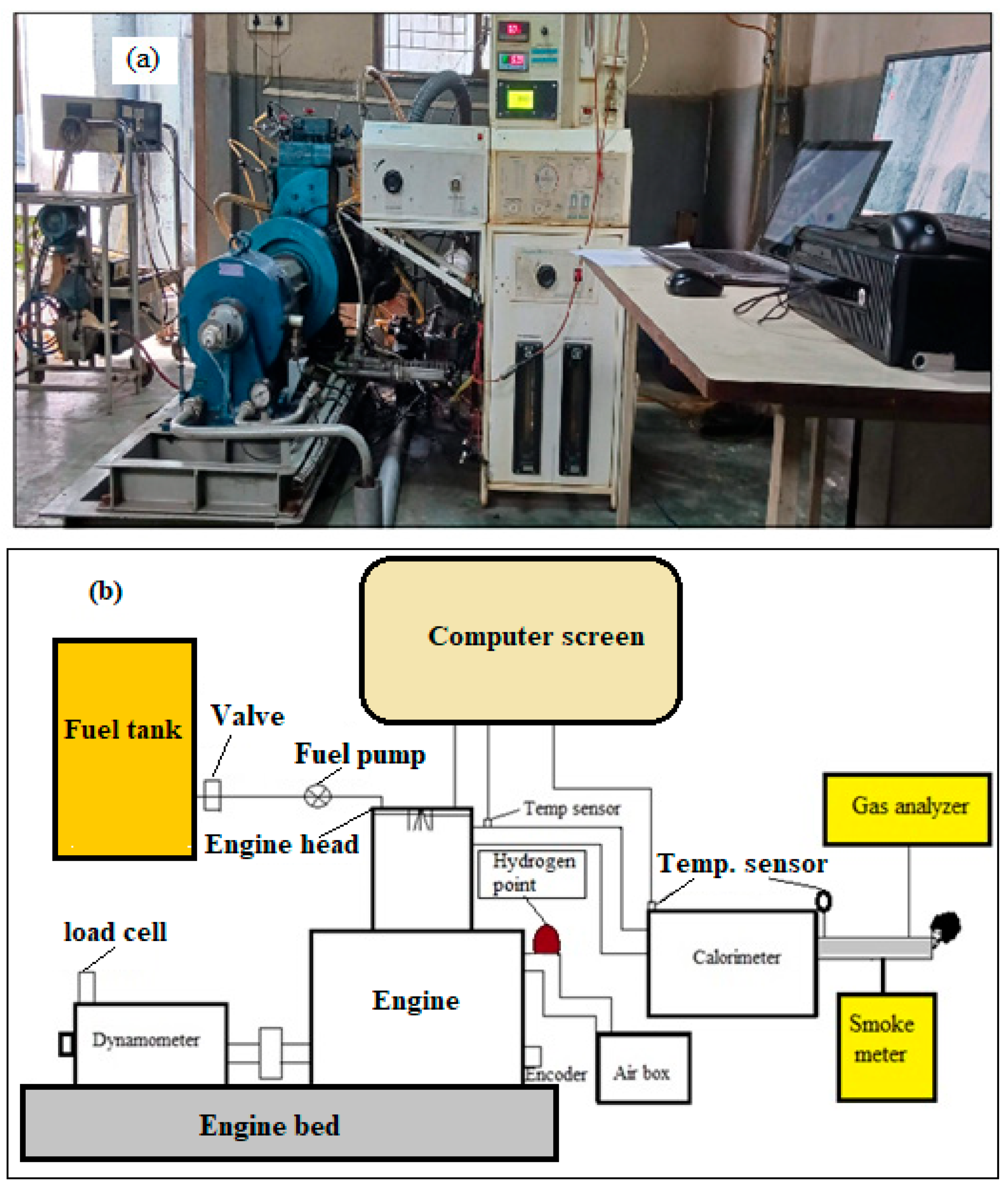
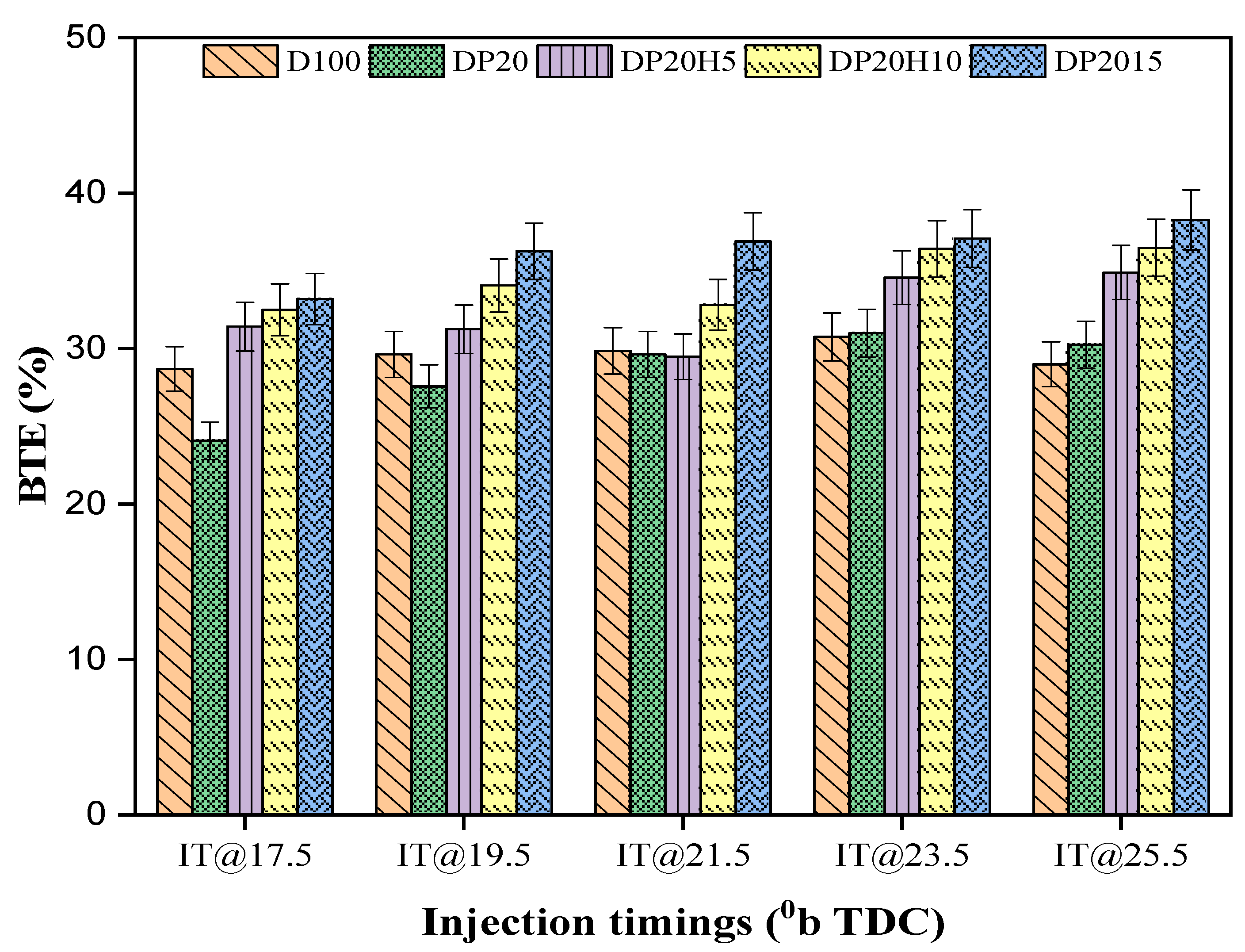
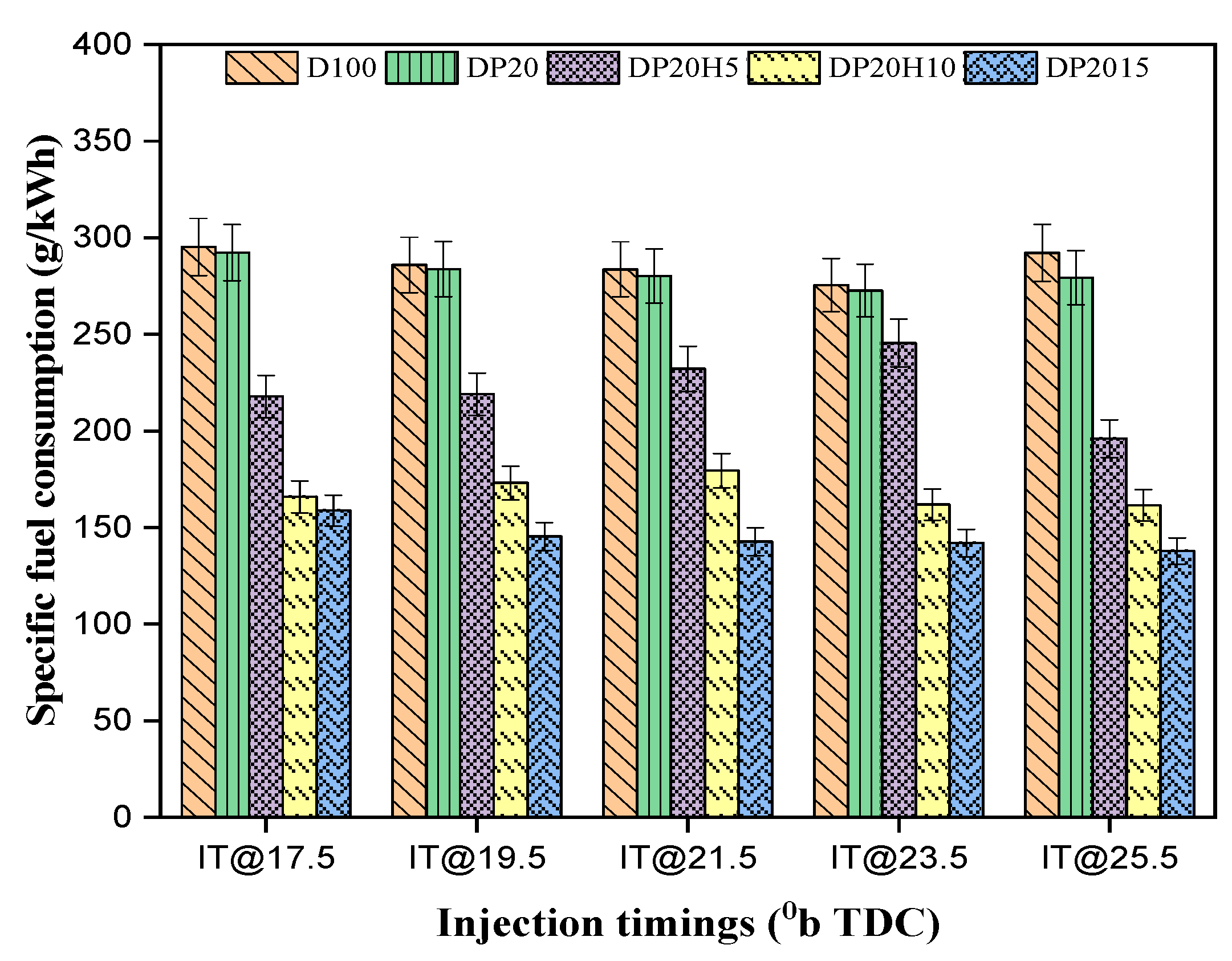
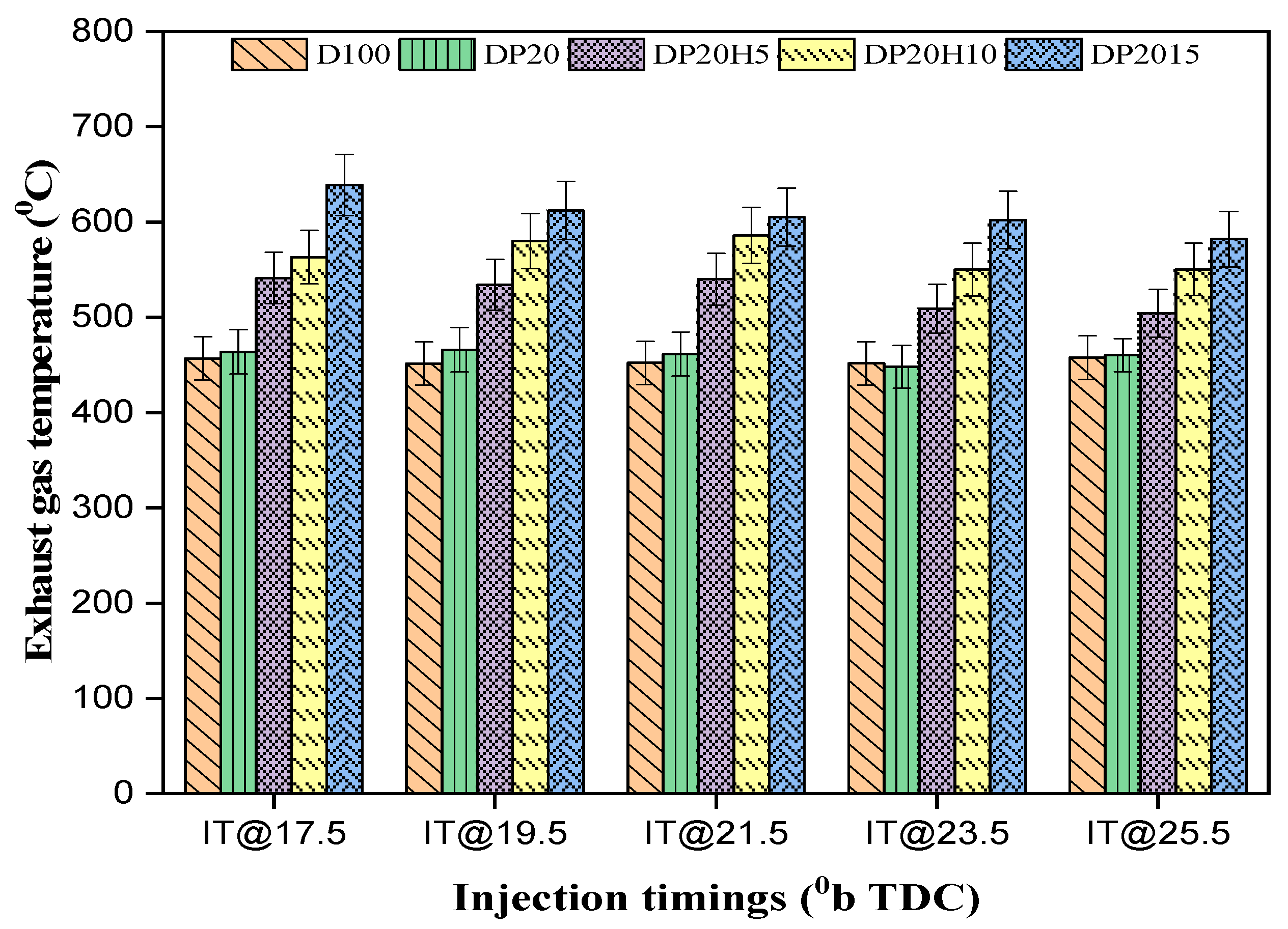
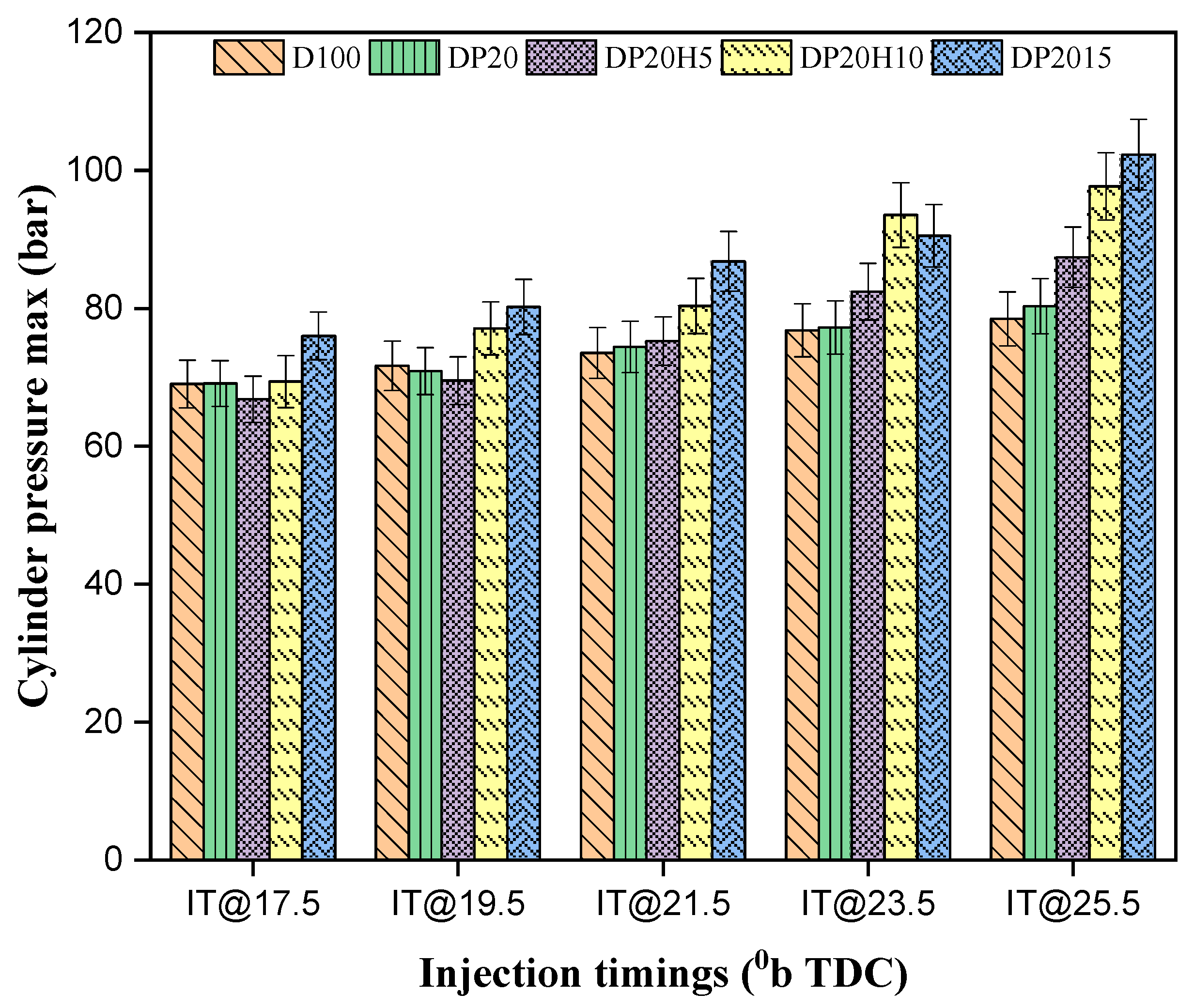
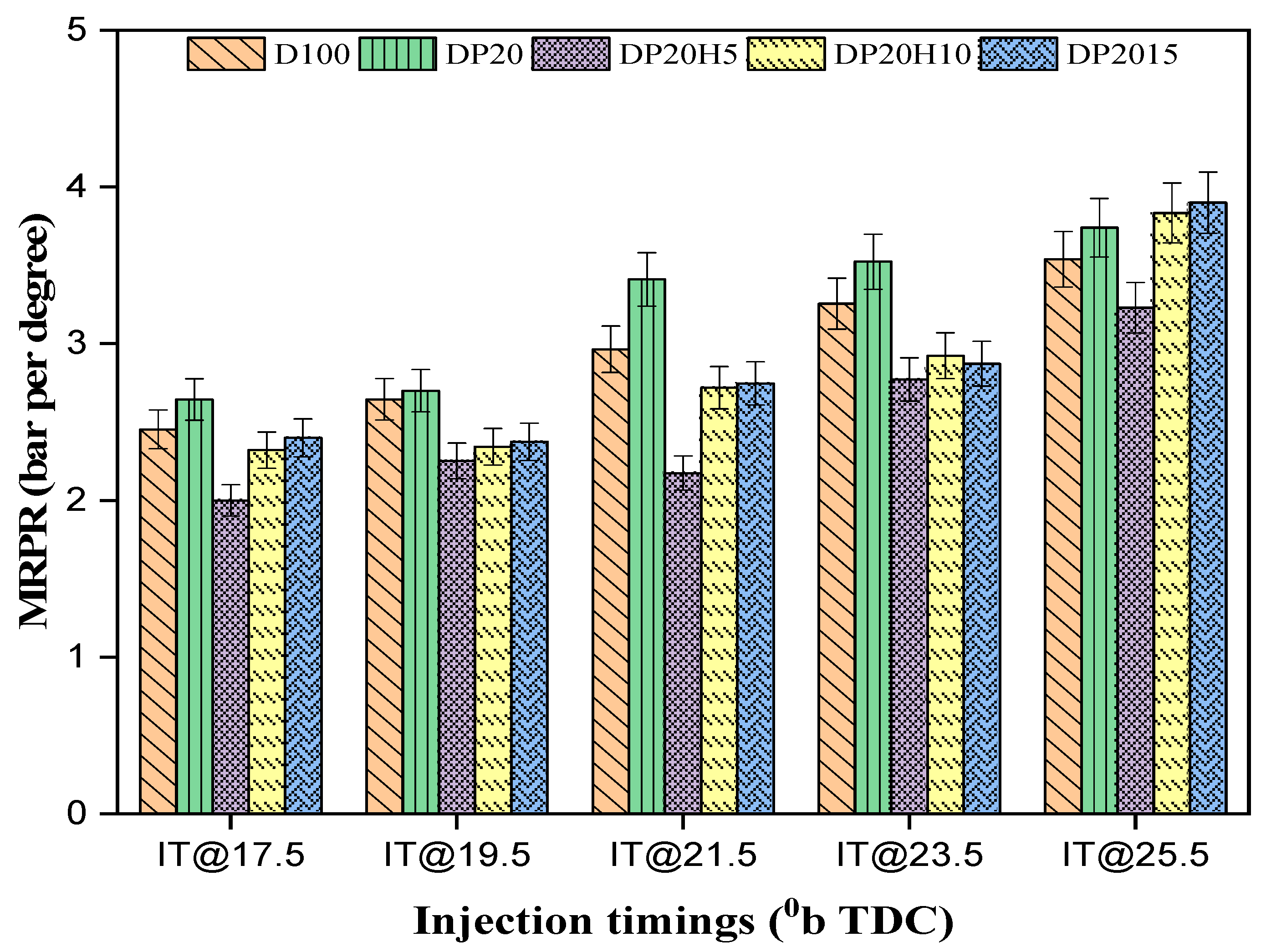
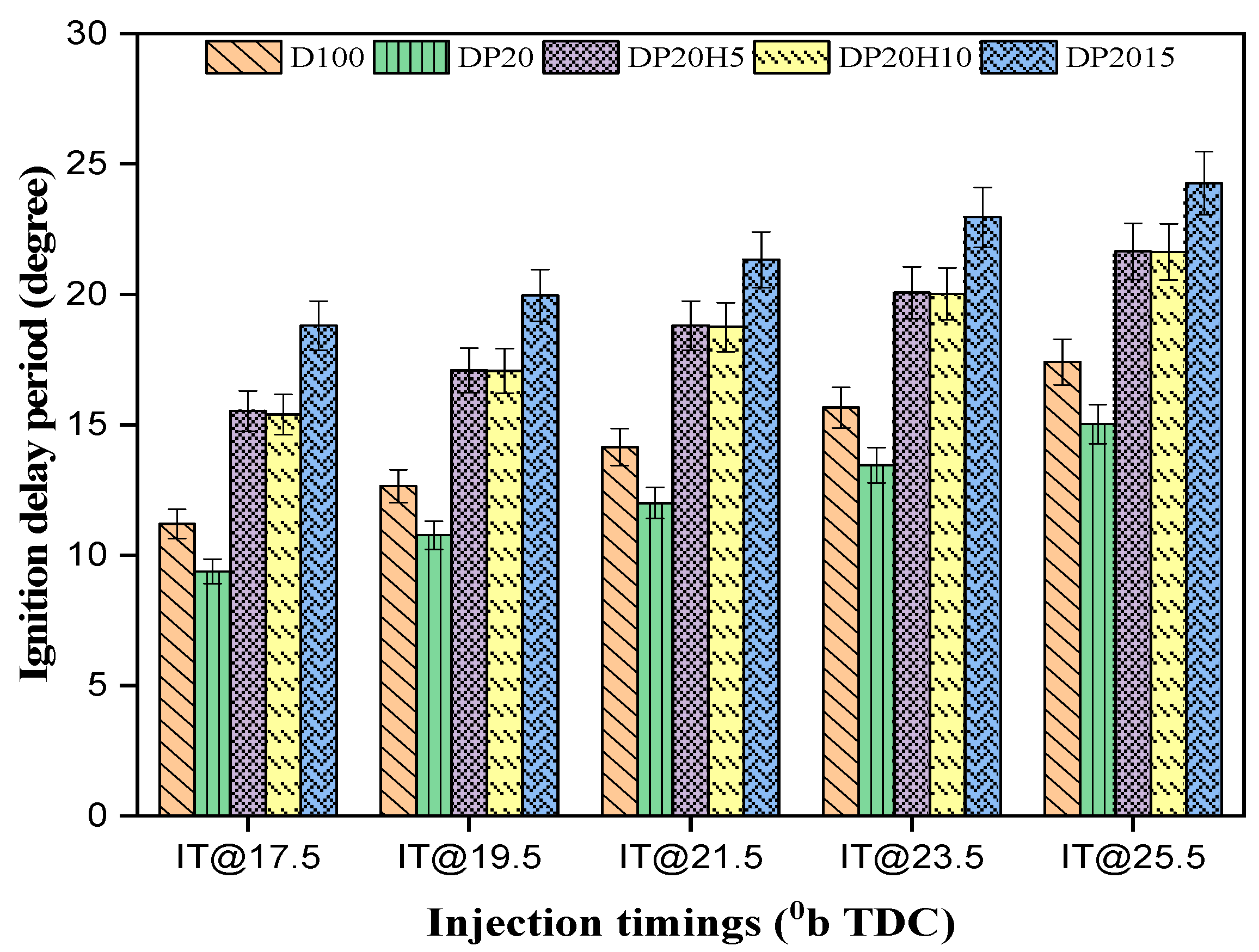
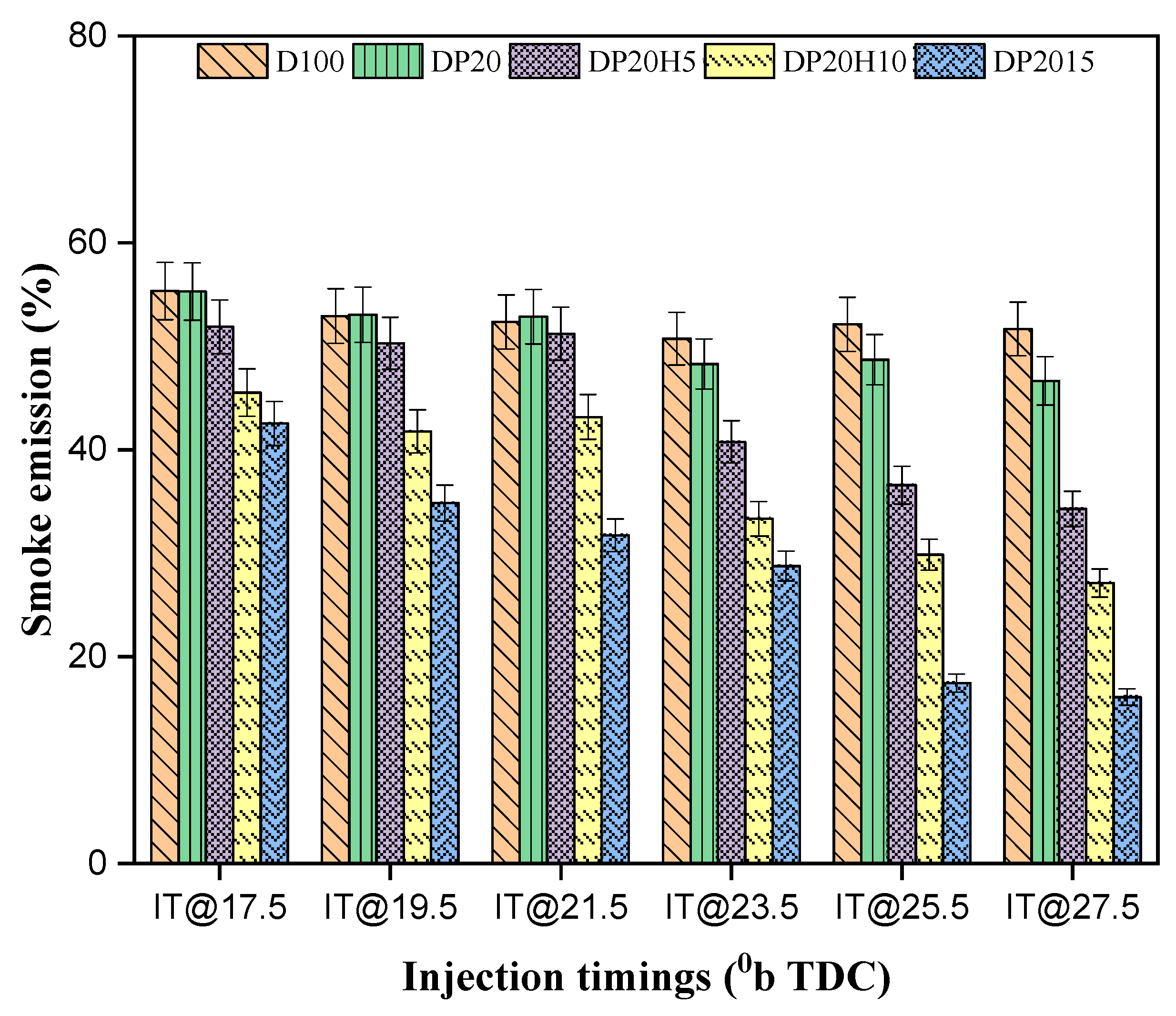
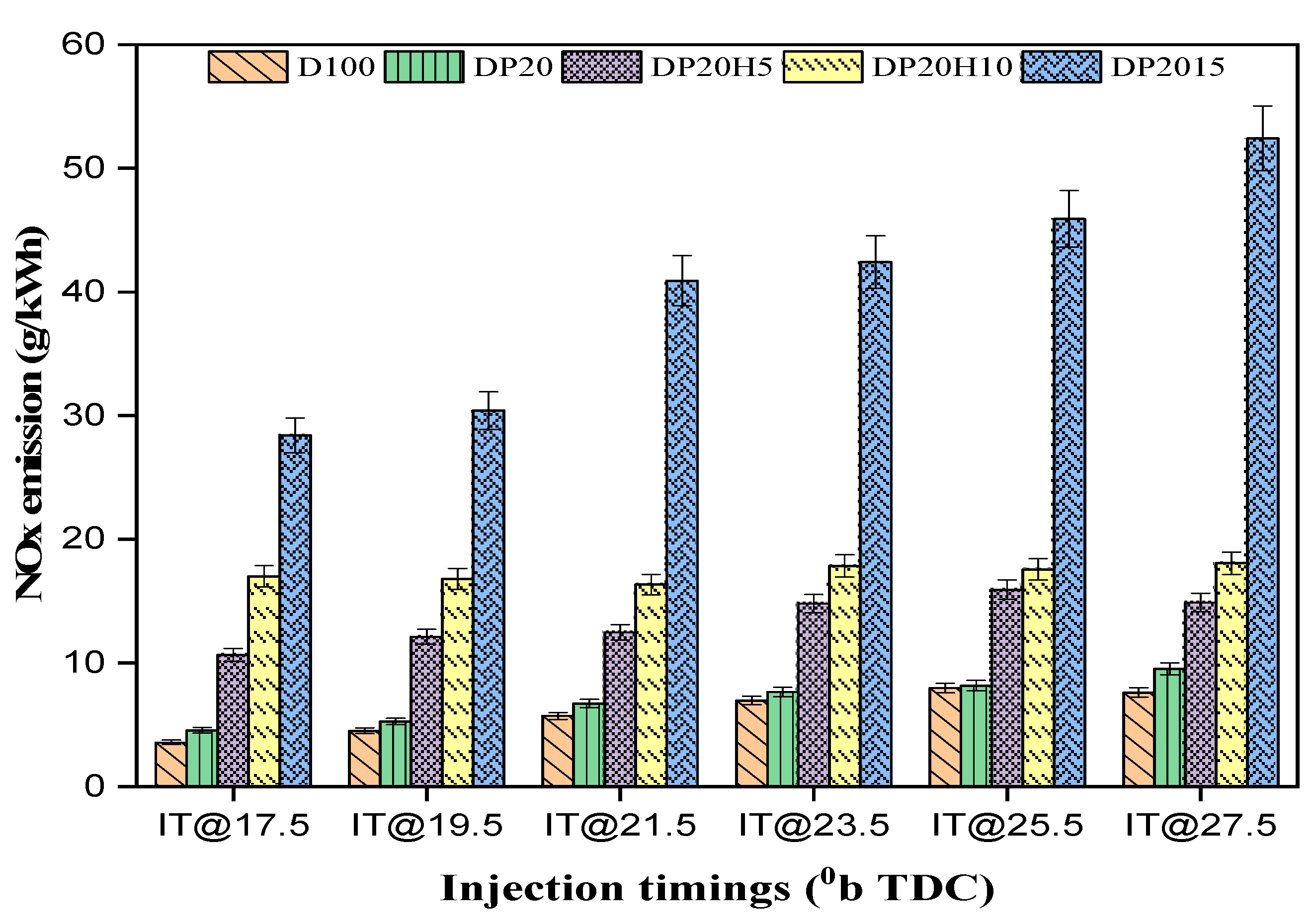
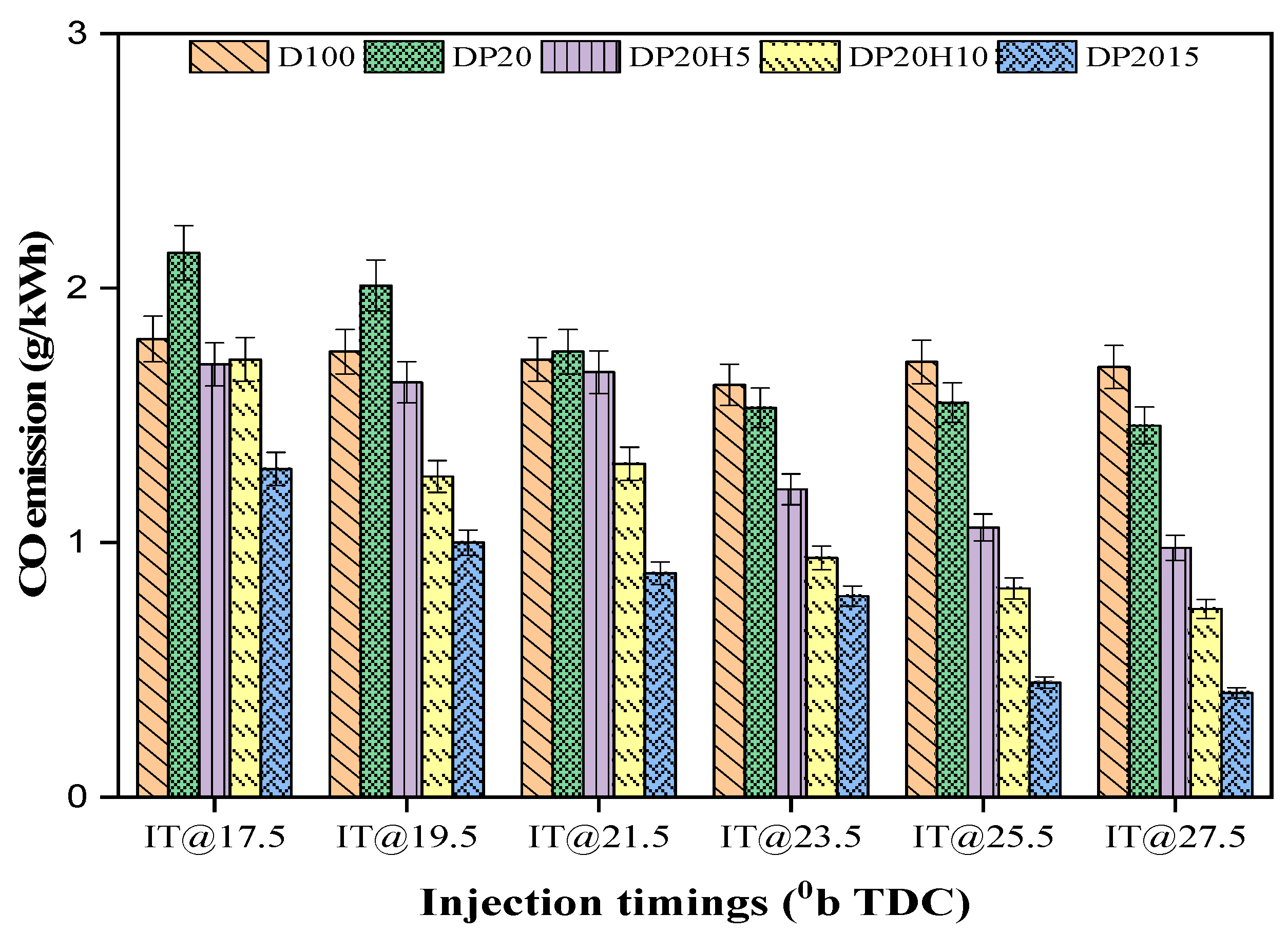
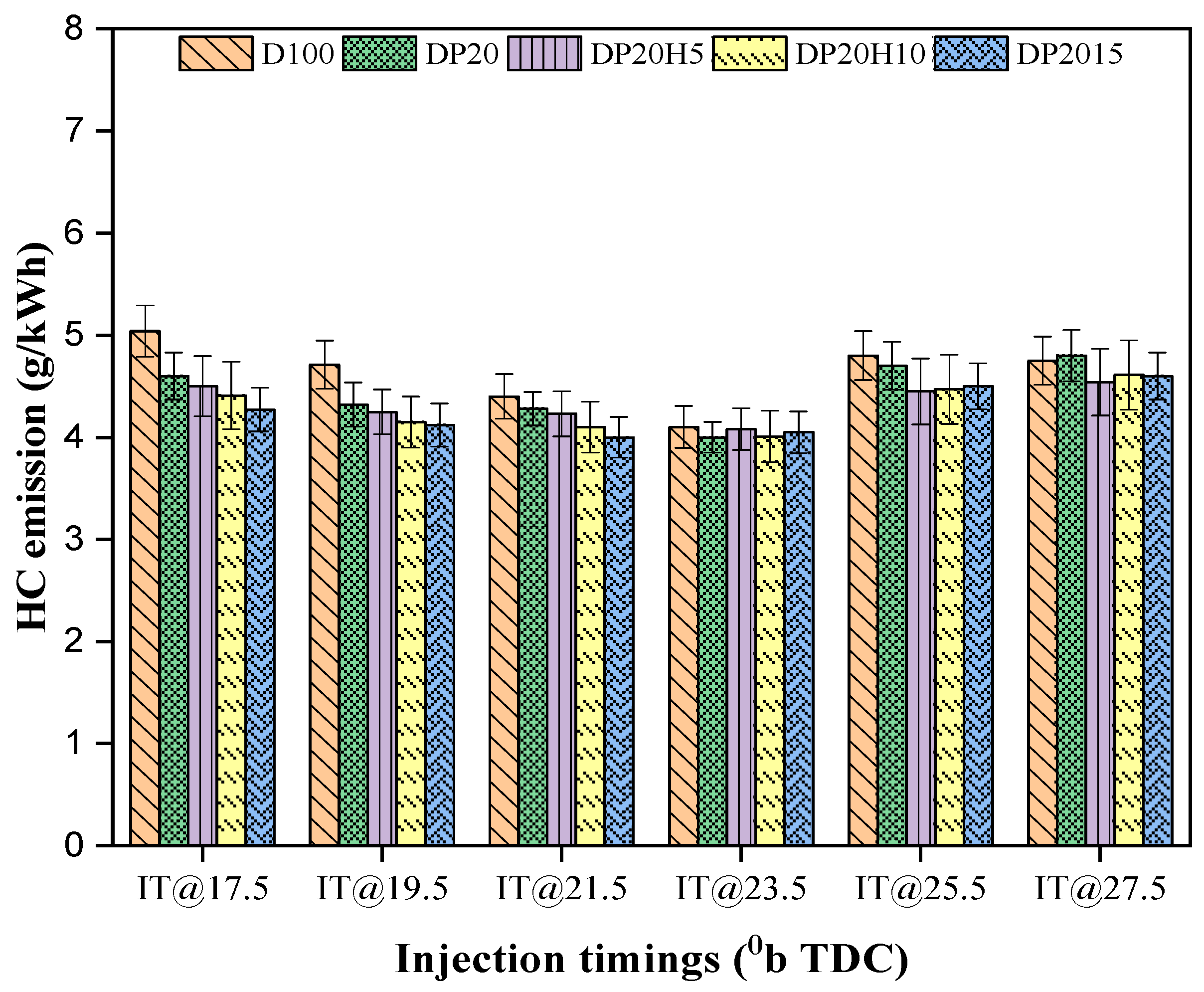
| Fuel | Hydrogen | Waste Plastics Oil | Diesel |
|---|---|---|---|
| Density (kg/m3) | 0.08 | 884.0 | 830 |
| Lower calorific value (MJ/kg) | 120 | 43.0 | 42.5 |
| Kinematic viscosity (mm2/s) @40 °C | 0.0083 | 3.64 | 3.0 |
| Sulphur Content | 00 | 0.03–0.35% [14] | 10 ppm (~0.001%) |
| Cetane number | 5–10 | 50 | 48–52 |
| Parameter | Value |
|---|---|
| Bore/stroke | 87.5 mm/110 mm |
| Compression ratio | 18:1 |
| Engine stroke/cylinder | 4/1 |
| Engine operating | 1500 rpm |
| Injection pressure | Higher of 220 bar |
| Injection timing | 19–26.0° b TDC |
| Cooling system | Water |
| Power | 5.2 kW |
| Limits | Uncertainty |
|---|---|
| BTE | ±2.0% |
| SFC | ±2.0% |
| HRR | ±1.0% |
| CO2 | ±0.2% |
| CO | ±0.2% |
| O2 | ±0.15% |
| HC | ±0.15% |
| NO | ±0.2% |
| Smoke meter | ±1.0% |
| Temperature sensor | ±0.5% |
| Pressure sensor | ±1.0% |
| Speed indicator | ±0.2% |
| Load indicator | ±0.2% |
| Encoder | ±0.2% |
Disclaimer/Publisher’s Note: The statements, opinions and data contained in all publications are solely those of the individual author(s) and contributor(s) and not of MDPI and/or the editor(s). MDPI and/or the editor(s) disclaim responsibility for any injury to people or property resulting from any ideas, methods, instructions or products referred to in the content. |
© 2024 by the authors. Licensee MDPI, Basel, Switzerland. This article is an open access article distributed under the terms and conditions of the Creative Commons Attribution (CC BY) license (https://creativecommons.org/licenses/by/4.0/).
Share and Cite
Reddy, K.J.; Rao, G.A.P.; Reddy, R.M.; Rajak, U. An Evaluation of the Effect of Fuel Injection on the Performance and Emission Characteristics of a Diesel Engine Fueled with Plastic-Oil–Hydrogen–Diesel Blends. Appl. Sci. 2024, 14, 6539. https://doi.org/10.3390/app14156539
Reddy KJ, Rao GAP, Reddy RM, Rajak U. An Evaluation of the Effect of Fuel Injection on the Performance and Emission Characteristics of a Diesel Engine Fueled with Plastic-Oil–Hydrogen–Diesel Blends. Applied Sciences. 2024; 14(15):6539. https://doi.org/10.3390/app14156539
Chicago/Turabian StyleReddy, Kodandapuram Jayasimha, Gaddale Amba Prasad Rao, Reddygari Meenakshi Reddy, and Upendra Rajak. 2024. "An Evaluation of the Effect of Fuel Injection on the Performance and Emission Characteristics of a Diesel Engine Fueled with Plastic-Oil–Hydrogen–Diesel Blends" Applied Sciences 14, no. 15: 6539. https://doi.org/10.3390/app14156539







